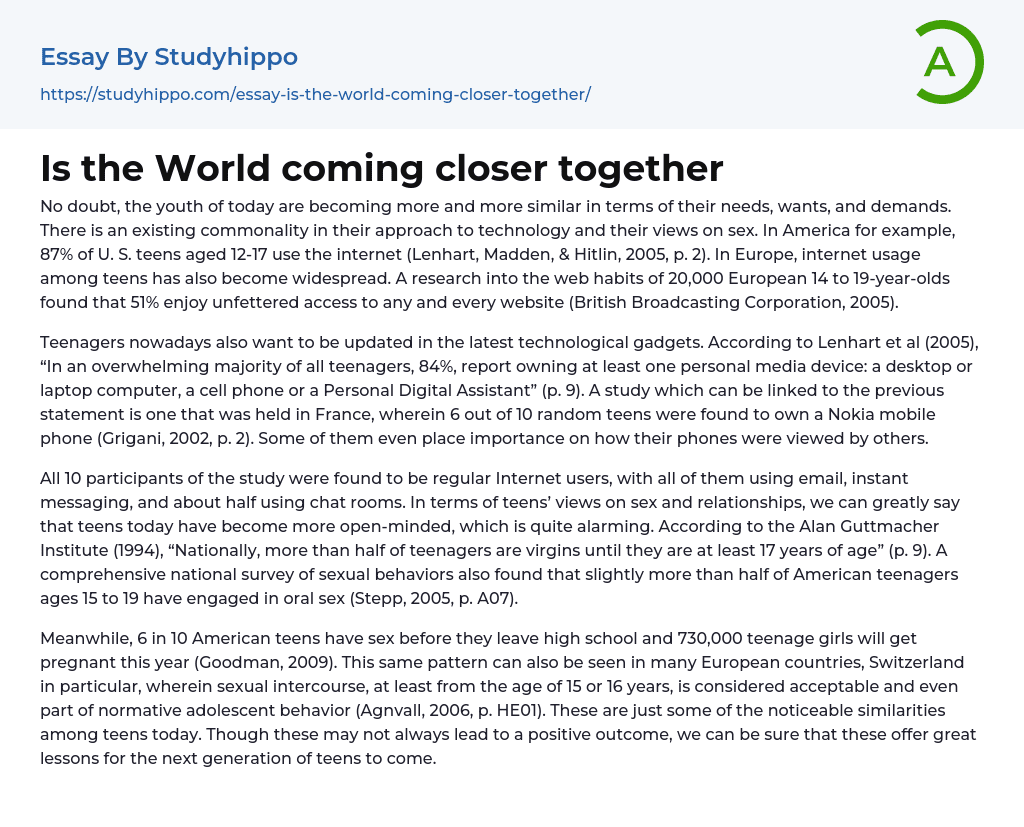No doubt, the youth of today are becoming more and more similar in terms of their needs, wants, and demands. There is an existing commonality in their approach to technology and their views on sex. In America for example, 87% of U. S. teens aged 12-17 use the internet (Lenhart, Madden, & Hitlin, 2005, p. 2). In Europe, internet usage among teens has also become widespread. A research into the web habits of 20,000 European 14 to 19-year-olds found that 51% enjoy unfettered access to any and every website (British Broadcasting Corporation, 2005).
Teenagers nowadays also want to be updated in the latest technological gadgets. According to Lenhart et al (2005), “In an overwhelming majority of all teenagers, 84%, report owning at least one personal media device: a desk
...top or laptop computer, a cell phone or a Personal Digital Assistant” (p. 9). A study which can be linked to the previous statement is one that was held in France, wherein 6 out of 10 random teens were found to own a Nokia mobile phone (Grigani, 2002, p. 2). Some of them even place importance on how their phones were viewed by others.
All 10 participants of the study were found to be regular Internet users, with all of them using email, instant messaging, and about half using chat rooms. In terms of teens’ views on sex and relationships, we can greatly say that teens today have become more open-minded, which is quite alarming. According to the Alan Guttmacher Institute (1994), “Nationally, more than half of teenagers are virgins until they are at least 17 years of age” (p. 9). A comprehensive
national survey of sexual behaviors also found that slightly more than half of American teenagers ages 15 to 19 have engaged in oral sex (Stepp, 2005, p. A07).
Meanwhile, 6 in 10 American teens have sex before they leave high school and 730,000 teenage girls will get pregnant this year (Goodman, 2009). This same pattern can also be seen in many European countries, Switzerland in particular, wherein sexual intercourse, at least from the age of 15 or 16 years, is considered acceptable and even part of normative adolescent behavior (Agnvall, 2006, p. HE01). These are just some of the noticeable similarities among teens today. Though these may not always lead to a positive outcome, we can be sure that these offer great lessons for the next generation of teens to come.
- Email essays
- Hypertext Transfer Protocol essays
- Marshall Mcluhan essays
- Virtual Learning Environment essays
- Web Search essays
- Etiquette essays
- Mainstream essays
- Vodafone essays
- Web Search Engine essays
- Male essays
- Same-Sex Marriage essays
- Masturbation essays
- Culture essays
- Social Control essays
- Citizenship essays
- Social Justice essays
- Caste System essays
- Social Responsibility essays
- Socialization essays
- Deviance essays
- Modern Society essays
- Popularity essays
- Civil Society essays
- Community essays
- Female essays
- Filipino People essays
- Igbo People essays
- Indigenous Australians essays
- Indigenous Peoples essays
- Minority Group essays
- Social Institution essays
- Men essays
- The nation essays
- Middle Class essays
- Social Norms essays
- Discourse Community essays
- Popular Culture essays
- Car Culture essays
- American Culture essays
- Mormon essays
- Indian Culture essays
- Mexican Culture essays
- Pop Culture essays
- Cultural Differences essays
- Culture Shock essays
- Different Cultures essays
- Adolescence essays
- Childhood essays
- Growth Mindset essays
- Individual essays




